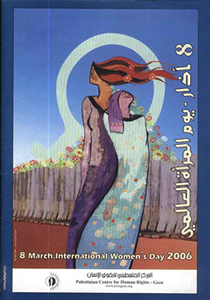 |
International
Women’s Day poster Palestinian Centre for Human Rights |
The day will come when men will recognize woman as his peer, not only at the fireside, but in councils of the nation. Then, and not until then, will there be the perfect comradeship, the ideal union between the sexes that shall result in the highest development of the race.
Susan B Anthony (1820-1906)
International Women’s Day (IWD) is marked on 8 March every year. It is a day of global celebration for the economic, political and social achievements of women.
The first National Woman’s Day was observed across the United States on 28 February 1909. The following year the Socialist International Movement, meeting in Copenhagen, proposed a global Women’s Day to honour the fight for women’s rights and to assist in achieving universal suffrage; the proposal was greeted with unanimous approval by the conference of delegates from 17 countries, although no fixed date was selected for the observance.
As a result of the decision taken at Copenhagen, the first International Women’s Day was observed on 19 March 1911 in Austria, Denmark, Germany and Switzerland. More than one million women and men attended rallies, demanding the right to vote, work and hold public office, the right of vocational training and an end to discrimination on the job.
As part of the movement for peace that arose in the face of upcoming war (WWI), Russian women observed their first International Women’s Day on the last Sunday in February 1913. Elsewhere in Europe—on or around 8 March of the following year—women held rallies either to protest the war or to express solidarity with their sisters.
Faced with nearly 4 million casualties of war, Russian women chose the last Sunday in February 1917—23 February in the Julian calendar, but 8 March on the Gregorian calendar used elsewhere—to strike for “bread and peace.” Four days after the strike the Czar was forced to abdicate; that same year the provisional government that took his place granted women the vote.
In the West, observance of International Women’s Day dwindled during the 1930s, only to be revived by the rise of feminism in the sixties; it has now assumed a global dimension for women in developed and developing countries alike.